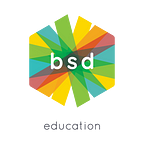Student Agency in Educational Technology Integrations
Written by Mo Qureshi, BSD Education
Earlier this month I was invited to present at the ACAMIS Spring Leadership Conferenceon Student Agency in Educational Technology Integrations. This article summarizes the key points from my presentation — definition and importance of student agency, concrete examples of student agency in action with teachers taking a lead in enabling this; and some tips school leaders can take back to school.
As Head of Learning Experience at BSD, a huge part of my job is to deliver professional development and coach teachers, as well as observe a wide variety of classroom settings. During coaching and classroom observations, I get the opportunity to see a wide variety of student agency in action.
But what is student agency? Eric Sheninger’s definition in his article, Student Agency: Moving from Talk to Action, captures the essence of what it’s about — “Student agency is about empowering kids to own their learning (and school) through greater autonomy. It is driven by choice, voice, and advocacy.”
Access to Internet-enabled devices in and outside the classroom has encouraged and allowed students to take control of their own learning. As educators, it’s now up to us to help students take responsible ownership of their learning as well as provide the right environment and support to nurture this.
In my visits to schools, I have observed that those which best promote student agency in technology settings have these common traits:
- They invest time and resources to develop clear and strong objectives and outcomes for teachers and students. After this is defined, choosing the right devices, infrastructure and software become easy.
2. The school leadership supports the decisions made by the teachers and promotes buy-in from the teaching community. Developing agency in students is, in fact, starts with giving the same autonomy to teachers to make their own decision.
3. They promote interdepartmental collaboration. Bringing together teachers with a wide range of skill sets and from different backgrounds helps bring out and inspires the best in everyone.
4. They listen to the student and parent community and involve them in the decision making process.
Now, if you are a teacher who uses technology in the classroom and wants to develop agency in your students here are some handy tips:
- Give up control: When you bring in technology and the internet in the classroom you open the world of new possibilities. This makes it impossible for you to plan every detail of your lesson plan so I recommend carving in ample time for exploration and tinkering.
- Let students decide: It’s time for the end of term project presentations? Encourage students to be creative and let them choose what they want to do — shoot a video, create a website, even enact it or just stick to a slideshow — the choice is entirely up to them! Doing so helps build confidence and bring out students’ hidden interests and skills.
- Engage your students by asking for suggestions and feedback:Ask students to peer review their work by giving each other “three stars and a wish” — three things you liked about your colleagues’ work and one thing you wish they would do next time.
- Solve open ended problems: Ask big questions to solve big problems. Questions like — “how would you decrease traffic congestion in X city?”, “how would you improve the food and water distribute chain so everyone gets equal access to it?”, “how would you incentivise people to pay their taxes?”, etc. Asking such questions opens the doors to a series of follow up questions encourages students to gain a deeper understanding of how complex systems work, which in turn helps them to potentially discover the root cause of the problem.
- Be a coach or facilitator for learning: When it comes to technology, students need a supportive and experienced adult to guide them. They also need an environment where trying, learning-by-doing, and not being afraid to make mistakes is encouraged.
If you would like to see my entire presentation and would like me to share it with you, get in touch with me at mq@bsd.education.
